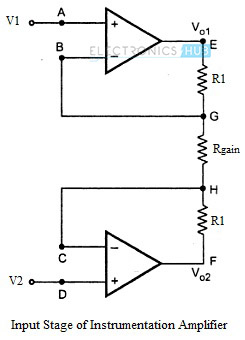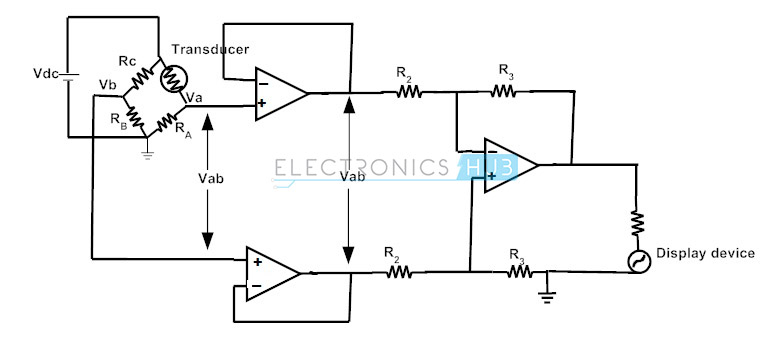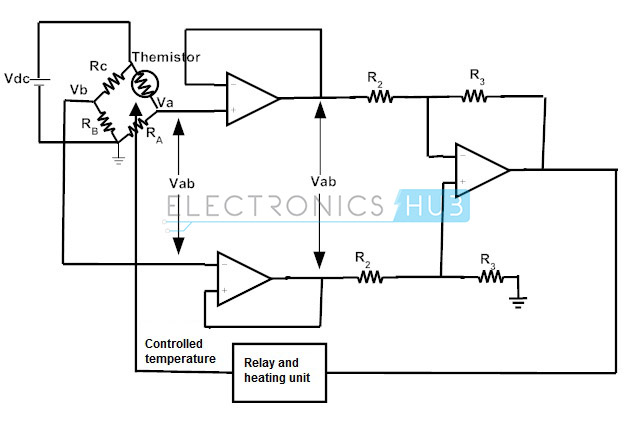A special implementation of Operational Amplifiers is the Instrumentation Amplifier, a type of Differential Amplifier with Input Buffer Amplifier. In this tutorial, we will learn about few important Instrumentation Amplifier Basics and Applications and also the circuit and working of a three Op-amp Instrumentation Amplifier.
If you want more information on the basics of Op-amp, read “Operational Amplifier Basics“ and for information on the basics of Differential Amplifier, read “Differential Amplifier“.
Introduction
Many industrial and consumer applications require the measurement and control of physical conditions. For example, measurements of temperature and humidity inside a diary plant to accurately maintain product quality, or precise control of the temperature of a plastic furnace to produce a particular grade of plastic, etc.
These changes in physical conditions must be converted to electrical quantities using transducers, and then amplified. Such amplifiers, which are used to amplify signals to measure physical quantities are commonly known as Instrumentation Amplifiers.
The input to an instrumentation amplifier is the output signal from the transducer. A transducer is a device which converts one form of energy into another. Most of the transducer outputs are of very low-level signals.
Hence, before the next stage, it is necessary to amplify the level of the signal, rejecting noise and the interference. The general single ended amplifiers are not suitable for such operations. For the rejection of noise, amplifiers must have high common-mode rejection ratio.
The special amplifier which is used for such low-level amplification with high CMRR, high input impedance to avoid loading is an Instrumentation Amplifier.
The instrumentation amplifier is intended for precise, low-level signal amplification where high input resistance, low noise and accurate closed-loop gain is required. Also, low power consumption, high slew rate and high common-mode rejection ratio are desirable for good performance.
Requirements of a Good Instrumentation Amplifier
An instrumentation amplifier is usually employed to amplify low-level signals, rejecting noise and interference signals. Therefore, a good instrumentation amplifier has to meet the following specifications:
Finite, Accurate and Stable Gain: Since the instrumentation amplifiers are required to amplify very low-level signals from the transducer device, high and finite gain is the basic requirement. The gain also needs to be accurate and the closed-loop gain must be stable.
Easier Gain Adjustment: Apart from a finite and stable gain, variation in the gain factor over a prescribed range of values is also necessary. The gain adjustment must be easier and precise.
High Input Impedance: To avoid the loading of input sources, the input impedance of the instrumentation amplifier must be very high (ideally infinite).
Low Output Impedance: The output impedance of a good instrumentation amplifier must be very low (ideally zero), to avoid loading effect on the immediate next stage.
High CMRR: The output from the transducer usually contains common mode signals, when transmitted over long wires. A good instrumentation amplifier must amplify only the differential input, completely rejecting common mode inputs. Thus, the CMRR of the instrumentation amplifier must be ideally infinite.
High Slew Rate: The slew rate of the instrumentation amplifier must be as high as possible to provide maximum undistorted output voltage swing.
Three Op-Amp Instrumentation Amplifier
The most commonly used Instrumentation amplifiers consist of three op-amps. In this circuit, a non-inverting amplifier is connected to each input of the differential amplifier.
This instrumentation amplifier provides high input impedance for exact measurement of input data from transducers . The circuit diagram of an instrumentation amplifier is as shown in the figure below.
The op-amps 1 & 2 are non-inverting amplifiers and together form an input stage of the instrumentation amplifier. The op-amp 3 is a difference amplifier that forms the output stage of the instrumentation amplifier.
Working of Instrumentation Amplifier
The output stage of the instrumentation amplifier is a difference amplifier, whose output Vout is the amplified difference of the input signals applied to its input terminals. If the outputs of op-amp 1 and op-amp 2 are Vo1 and Vo2 respectively, then the output of the difference amplifier is given by,
Vout = (R3/R2)(Vo1-Vo2)
The expressions for Vo1 and Vo2 can be found in terms of the input voltages and resistances. Consider the input stage of the instrumentation amplifier as shown in the figure below.
The potential at node A is the input voltage V1. Hence the potential at node B is also V1, from the virtual short concept. Thus, the potential at node G is also V1.
The potential at node D is the input voltage V2. Hence the potential at node C is also V2, from the virtual short. Thus, the potential at node H is also V2.
Ideally the current to the input stage op-amps is zero. Therefore the current I through the resistors R1, Rgain and R1 remains the same.
Applying Ohm’s law between the nodes E and F,
I = (Vo1-Vo2)/(R1+Rgain+R1) ——————— 1
I = (Vo1-Vo2)/(2R1+Rgain)
Since no current is flowing to the input of the op-amps 1 & 2, the current I between the nodes G and H can be given as,
I = (VG-VH)/Rgain = (V1-V2)/Rgain ————————- 2
Equating equations 1 and 2,
(Vo1-Vo2)/(2R1+Rgain) = (V1-V2)/Rgain
(Vo1-Vo2) = (2R1+Rgain)(V1-V2)/Rgain —————— 3
The output of the difference amplifier is given as,
Vout = (R3/R2) (Vo1-Vo2)
Therefore, (Vo1 – Vo2) = (R2/R3)Vout
Substituting (Vo1 – Vo2) value in the equation 3, we get
(R2/R3)Vout = (2R1+Rgain)(V1-V2)/Rgain
i.e. Vout = (R3/R2){(2R1+Rgain)/Rgain}(V1-V2)
The above equation gives the output voltage of an instrumentation amplifier. The overall gain of the amplifier is given by the term (R3/R2){(2R1+Rgain)/Rgain}.
Note:
- The overall voltage gain of an instrumentation amplifier can be controlled by adjusting the value of resistor Rgain.
- The common mode signal attenuation for the instrumentation amplifier is provided by the difference amplifier.
Advantages of Three Op-amp Instrumentation Amplifier
- The gain of a three op-amp instrumentation amplifier circuit can be easily varied and controlled by adjusting the value of Rgain without changing the circuit structure.
- The gain of the amplifier depends only on the external resistors used. Hence, it is easy to set the gain accurately by choosing the resistor values carefully.
- The input impedance of the instrumentation amplifier is dependent on the non-inverting amplifier circuits in the input stage. The input impedance of a non-inverting amplifier is very high.
- The output impedance of the instrumentation amplifier is the output impedance of the difference amplifier, which is very low.
- The CMRR of the op-amp 3 is very high and almost all of the common mode signal will be rejected.
Transducer Bridge Instrumentation Amplifier
The resistive transducer bridge is a network of resistors whose resistance varies due to changes in some physical condition. For example, Thermistors change their resistance with temperature and Light Dependent Resistors change their resistance to change in light intensity.
By making such a bridge as a part of the circuit, it is possible to produce an electrical signal proportional to the change in the physical quantity being measured.
Such an electrical signal can be amplified and used to monitor and control the physical process. An instrumentation amplifier can be constructed with a transducer bridge connected to one of its input terminals, as shown in the figure below.
Let the resistance of the transducer device in the resistive bridge be RT and the change in its resistance be ΔR. The effective resistance of the transducer device is RT ±ΔR. The resistive bridge is supplied with a DC voltage, Vdc.
When the bridge is balanced, i.e. at some reference condition of the physical quantity being measured, we get,
Va = Vb
RA(Vdc)/(RA+RT) = RB(Vdc)/(RB+RC)
Under this condition, the differential input to the instrumentation amplifier is
VDiff = Vb – Va = 0
Thus, the output of the amplifier is zero. Consequently, the display device connected at the output displays the reference value of the physical quantity being measured.
The reference condition is generally chosen by the designer and it depends on the device characteristics of the transducer, the type of physical quantity being measured and the type of the application.
When there is a change in the physical quantity being measured, the voltage Va will no longer be equal to Vb. This is because the resistance of the transducer device changes from RT to (RT ± ΔR).
This produces a differential input for the instrumentation amplifier and the output of the amplifier will no longer be zero.
The resistances RB and RC are constant and hence the voltage VB remains same as before, i.e.
Vb = RB(Vdc)/(RB+RC)
But the voltage Va changes due to the change in resistance of the transducer device and is now given as,
Va = RA(Vdc)/(RA+RT+ ΔR)
The differential voltage VDiff is,
VDiff = Vb – Va
VDiff = {RB(Vdc)/(RB+RC)} – {RA(Vdc)/(RA+RT+ ΔR)}
If all the resistances in the circuit are chosen to be of same value, i.e. RA = RB = RC = RT = R
VDiff = {R(Vdc)/(2R)} – {R(Vdc)/(2R+ ΔR)}
VDiff = {RVdc[2R+ΔR] – R.Vdc.2R}/ 2R(2R+ΔR)
VDiff = R.Vdc[2R+ΔR-2R]/{2R(2R+ΔR)}
VDiff = ΔR(Vdc)/{2(2R+ΔR)}
If the value of VDiff is positive, it indicates that Vb is greater than Va.
The output of the instrumentation amplifier is given as,
VO = (R3/R2)Vd
Vo = (R3/R2) [ΔR(Vdc)/{2(2R+ΔR)}]
As the change in resistance ΔR << 2R, Vo can be written as,
Vo = (R3/R2)[ΔR/4R](Vdc)
From the above equation, it can be noted that the output depends on the change in the resistance ΔR. The display can be calibrated in terms of the units of the physical quantity being measured.
Applications of Instrumentation Amplifier
The instrumentation amplifier, along with a transducer bridge can be used in a wide variety of applications. These applications are generally known as data acquisition systems.
At the input stage, there is a transducer device that converts the change in the physical quantity to an electrical signal.
The electrical signal is fed to an instrumentation amplifier. The amplified signal is then fed to a display device, which is calibrated to detect the change in the quantity being measured.
Temperature Controller
A simple temperature controller system can be constructed using a thermistor as the transducer device, in the resistive bridge, as shown in the figure above.
The resistive bridge is kept balanced for some reference temperature. For any change in this reference temperature, the instrumentation amplifier will produce an output voltage, which drives the Relay which in turn turns ON/OFF the heating unit, thereby controlling the temperature.
Temperature Indicator
The circuit shown for temperature controller can also be used as a temperature indicator. The resistive bridge is kept balanced for a particular reference temperature when Vo = 0V.
The temperature indicating meter is calibrated to reference temperature, corresponding to this reference condition.
As temperature changes, the amplifier output also changes. The gain of the amplifier can be appropriately set to indicate the desired range of temperature.
Light Intensity Meter
The same circuit can be used to detect variations in the intensity of light, by replacing the thermistor by a Light Dependent Resistor (LDR). The bridge is set to a balanced condition in darkness.
When light falls on the LDR, its resistance changes and unbalances the bridge. This causes the amplifier to produce a finite output, which in turn drives the meter.
Previous – Differential Amplifier
The post Instrumentation Amplifier Basics and Applications appeared first on Electronics Hub.




0 Comments